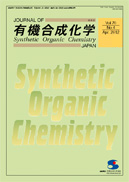巻号一覧

70 巻, 12 号
選択された号の論文の8件中1~8を表示しています
- |<
- <
- 1
- >
- >|
巻頭言
-
及川 英秋2012 年 70 巻 12 号 p. 1241
発行日: 2012/12/01
公開日: 2013/02/06
ジャーナル オープンアクセスPDF形式でダウンロード (794K)
総説および総合論文
-
波多野 学2012 年 70 巻 12 号 p. 1242-1254
発行日: 2012/12/01
公開日: 2013/02/06
ジャーナル 認証ありTo surpass enzymes, the potential of supramolecular catalysts to realize anomalous stereoselectivity in organic synthesis is highly attractive. However, to date, there have been a few examples of non-polymeric and non-covalent chiral supramolecular catalysts that induce both practical yield and excellent stereoselectivity. To establish high catalytic activity with anomalous stereoselectivity, in principle, an artificial cage should be conformationally flexible, like an active pocket in an enzyme with an induced-fit function. In this article, we focus on the anomalous endo/exo-selective enantioselective Diels-Alder reaction, and show the development of the successive catalysts including our recent highly active, conformationally flexible, and chiral supramolecular catalysts. The evolution from ‘ready-made’ single-molecule catalysts to ‘tailor-made’ supramolecular catalysts could offer not only high enantioselectivity but also high anomalous endo/exo-selectivity due to substrate-specific characteristics, as with enzymes.抄録全体を表示PDF形式でダウンロード (4365K) -
戸部 義人2012 年 70 巻 12 号 p. 1255-1266
発行日: 2012/12/01
公開日: 2013/02/06
ジャーナル 認証ありTwo-dimensional (2D) architectures, particularly porous molecular networks, on solid surfaces formed via self-assembly have received a great deal of interest because of the prospective applications in optoelectronics and tailor-made catalysis. We found that porous 2D molecular networks were formed at liquid-solid interfaces, typically an organic solvent/graphite or Au(111), by triangle-shaped phenylene-ethynylene macrocycles, dehydrobenzo[12]annulenes (DBAs), via their self-assembly by van der Waals interactions between the interdigitated alkyl chains attached to the periphery of the macrocyclic core. Factors that led to the preferential formation of porous, honeycomb-shaped networks were elucidated including the size of the π-conjugated cores, alkyl chain length, solvent, concentration, temperature, and solid substrates. Not only homochiral molecular networks were achieved by self-assembly of DBAs with chiral side chains, but also network homochirality was induced by addition of a small amount of a chiral DBA into an achiral DBA as a chirality inducer. Co-adsorption of guest molecules in the pores occurred through recognition of the size and shape, leading to selective inclusion of homo-molecular as well as hetero-molecular clusters into the nanowells. Moreover, the interior of the pores was functionalized for tailored molecular recognition toward advanced use of 2D molecular networks on surfaces.抄録全体を表示PDF形式でダウンロード (3913K) -
平野 雅文, 小峰 伸之, 小宮 三四郎2012 年 70 巻 12 号 p. 1267-1280
発行日: 2012/12/01
公開日: 2013/02/06
ジャーナル 認証ありA series of catalytic linear dimerizations of substituted alkenes and dienes are promoted by zero-valent ruthenium complexes. These reactions are considered to proceed by an oxidative coupling mechanism because some key intermediates such as a ruthenacyclopentane have been isolated. The key for the reaction is 4π and 2π coordinations in a 6-electron coordination site on highly Lewis basic Ru (0), where chemo-, prochiral and regio-selective coordination and coupling reaction of substrates are taking place to give the linear dimers.抄録全体を表示PDF形式でダウンロード (1930K) -
相川 光介, 三上 幸一2012 年 70 巻 12 号 p. 1281-1294
発行日: 2012/12/01
公開日: 2013/02/06
ジャーナル 認証ありIn asymmetric catalysis, many chiral ligands, atropisomeric (atropos) ones in particular, have so far been reported to attain excellent results. The word atropos consists of “a” meaning “not” and “tropos” meaning “turn” in Greek, and thus the dynamic behavior of a ligand with chirality (i.e. axis, planar, center, and helicity) can be referred to as tropos. In this paper, an advanced strategy for asymmetric activation using racemic catalysts is highlighted by the introduction of tropos ligands. The combination of a tropos ligand, a chiral activator (a chiral controller, in part), and a metal atom can, in principle, forms a single diastereomer. Through the asymmetric activation, the catalytic activity can be increased and the chiral environment of the catalyst obtained can be amplified for effective asymmetric catalysis. Additionally, the atropos enantiopure catalysts can also be isolated after the dissociation of chiral activators (referred to as controllers in this case) from the catalyst. Based on this concept, we have developed asymmetric catalysis based on tropos ligands, especially BIPHEPs.抄録全体を表示PDF形式でダウンロード (4147K) -
関 雅彦2012 年 70 巻 12 号 p. 1295-1304
発行日: 2012/12/01
公開日: 2013/02/06
ジャーナル 認証ありA highly efficient catalytic system for C-H bond activation has been developed which involves inexpensive ruthenium(II) chloride hydrate and a specific amount of triphenyl phosphine. The procedure has been successfully applied to a novel and practical synthesis of angiotensin II receptor blockers (ARBs). The residual ruthenium existed in the reaction mixture was thoroughly removed by the treatment with properly chosen metal scavengers. The new process permits a ready access to the important class of drugs in highly atom-economical and sustainable manner.抄録全体を表示PDF形式でダウンロード (2717K)
Review de Debut
-
赤川 賢吾2012 年 70 巻 12 号 p. 1305-1306
発行日: 2012/12/01
公開日: 2013/02/06
ジャーナル オープンアクセスCatalytic regioselective reactions have a great potential for the development of novel synthetic schemes. However, controlling reactivity of multiple functional groups in a substrate is a difficult challenge because of the lack of a general strategy. Recently, several novel catalytic systems have been developed for overturning inherent regioselectivity.抄録全体を表示PDF形式でダウンロード (1134K)
十字路
-
波多野 学, 戸部 義人, 平野 雅文, 相川 光介, 三上 幸一2012 年 70 巻 12 号 p. 1307
発行日: 2012/12/01
公開日: 2013/02/06
ジャーナル オープンアクセスPDF形式でダウンロード (777K)
- |<
- <
- 1
- >
- >|